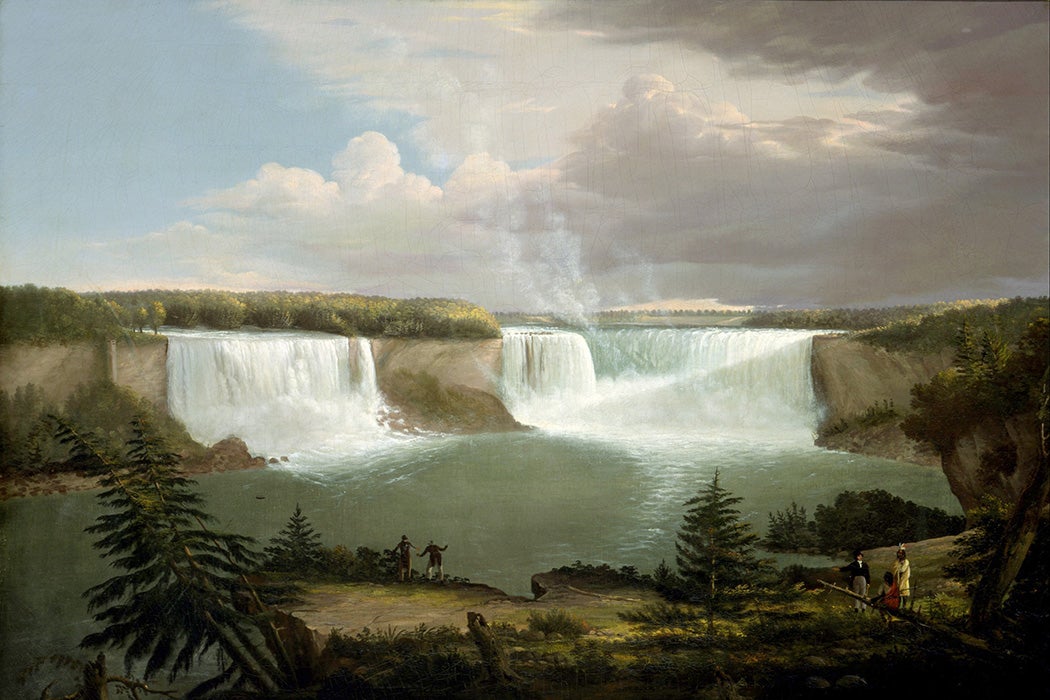In 1822, Gideon Davison, a printer in Sarasota Springs, New York, published The Fashionable Tour: or, A Trip to the Springs, Niagara, Quebeck, and Boston, in the Summer of 1821. It’s been called the first American tourist guidebook. Davison “proved highly influential,” writes historian Will B. Mackintosh, with his “particular combination of geographical facts and figures, landscape description, brief historical sketches, and practical route information in distance charts and timetables.”
Davison himself wrote that he wrote and published the guide “that it might serve the purpose of a small pocket volume of references, such facts only have been collected as will render it more particularly interesting to the tourist.” The guide’s geographical genesis is significant: Sarasota Springs developed into the largest mineral springs resort in the US, especially booming after the Saratoga and Schenectady Railroad connected the resort into the nation’s growing rail network in 1832.
But where did Davison get the idea for a combination of features that still mark tourist guidebooks and their digital offspring nearly two centuries later? Mackintosh points to two sources: travel narratives of the eighteenth and early nineteenth centuries and “road books” designed to assist travelers getting places before the advent of standardized routes and signs.
Travel narratives were first person accounts of travel, but many authors of these works “invited readers to replicate their journeys and their experiences.” They also often made an effort to “develop codes to help such readers on the road.” Mariana Starke’s 1802 Travels in Italy, for instance, used exclamation points to rate places, an influential forebear of the rating systems still used by tourist guidebooks and restaurant guides.
With his subtitle, Davison was consciously emulating travel narratives, a popular genre in the US. He wrote as if the tour he was detailing took place during “the summer of 1821.” But unlike travel narrative authors, he kept himself out of the story. Readers weren’t supposed to vicariously travel with him, they were supposed to use his information to travel themselves. And by adding the details of “directions, distances, timetables, and fares,” he tapped into the road book tradition.
“Road books were small, portable, frequently updated volumes designed to assist travelers with the basic tasks of navigation over unfamiliar roads,” explains Mackintosh. Containing itineraries and, often, maps, road books dated to the seventeenth century in Great Britain. After 1750, “the genre exploded in size, scope, and popularity there.” Several authors and publishers, some of them British immigrants to the US, tried to replicate that British popularity.
But road books largely failed to take hold in the US. Britain may have been “Great,” but it wasn’t very big, especially in comparison to a nation expanding across North America. With a much better road system and stronger publishing industry, road books fit well with travelers in England, Wales, and Scotland. The US simply didn’t have a national road system: roads “were profoundly local in orientation.” Notes Mackintosh, American travel was “highly improvisational” into the early nineteenth century.
“The economic structure of early national print made the production of a useful road book exceeding difficult [in the US],” he writes, “and the underdeveloped road network of the era meant that even those that were produced were of limited utility to actual travelers.”
Weekly Newsletter
The idea of the road book was a good one, though. By the 1810s, both US roads and publishers were in better shape for producing road books, but the market was changing. Travelers now wanted more than just way-finding guides.
Davison’s combination of way-finding with practical information about services/amenities and costs thereof, along with social, historical, and geographical information, actually wasn’t a big seller in its first, pamphlet-like edition. But it soon caught on. It “was regularly reissued in ever-expanding editions for the next twenty years,” Mackintosh writes. The Fashionable Tour sparked a host of imitators and a long-lived genre.
Teaching Tips
Explore pedagogical approaches: a special issue of CEA Critic offers substantive discussions about teaching travel literature, including an introductory essay by Scott Christianson and Julia M. Gergits and Syrine C. Hout’s article, “Reading Travel Writing in Two Theme-Based Graduate Seminars.”
Consider the global context: Pieter François analyzes the origins of the modern travel guide, with a geographic focus on Belgium.
Support JSTOR Daily! Join our membership program on Patreon today.







